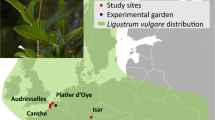Abstract
The restricted perennial diploid herb,Villarsia lasiosperma, of southwestern Western Australia has distylous flowers with dimorphism in style and stamen length, stigma morphology, and pollen size. In order to assess the presence and nature of an incompatibility system in this species, a crossing program was carried out using 17 plants grown from seeds collected in two field populations. Pollen stainabilities of these plants mostly exceeded 95%. Mean seed-set of Longs following intermorph pollinations was c. 24 seeds per pollination and for Shorts was c. 16 seeds per pollination. Approximately three-quarters of the Longs and Shorts produced no seeds after self-pollination; the remainder produced very few seeds following such pollinations. No Shorts produced seeds after intramorph cross-pollinations. However, about half the Longs exhibited various levels of weakened intramorph incompatibility, with mean seed-sets following intramorph cross-pollinations up to half the mean seed-sets following intermorph pollinations. In the behavior of Longs, the incompatibility system ofV. lasiosperma differs from the idealized distylous breeding system, but resembles that of a purported close relative,V. exaltata of eastern and southeastern Australia.
Similar content being viewed by others
References
Aston, H. I., 1969: The genusVillarsia (Menyanthaceae) in Australia. — Muelleria2: 3–63.
Barrett, S. C. H., 1985: Floral trimorphism and monomorphism in continental and island populations ofEichhornia paniculata (Spreng.)Solms (Pontederiaceae). — Biol. J. Linn. Soc.25: 41–60.
, 1985: Variation in expression of trimorphic incompatibility inPontederia cordata L. (Pontederiaceae). — Theor. Appl. Genet.70: 355–362.
, 1990: Variation in outcrossing rates inEichhornia paniculata: the role of demographic and reproductive factors. — Pl. Spec. Biol.5: 41–55.
Darwin, C., 1877: The different forms of flowers on plants of the same species. — London: Murray.
Ganders, F. R., 1975: Fecundity in distylous and self-incompatible homostylous plants ofMitchella repens (Rubiaceae). — Evolution29: 186–188.
, 1979a: Heterostyly inErythroxylum coca (Erythroxylaceae). — Biol. J. Linn. Soc.78: 11–20.
, 1979b: The biology of heterostyly. — New Zealand J. Bot.17: 607–635.
Glover, D. E., Barrett, S. C. H., 1986: Variation in the mating system ofEichhornia paniculata (Spreng.)Solms (Pontederiaceae). — Evolution40: 1122–1131.
Goldblatt, P., Bernhardt, P., 1990: Pollination biology ofNivenia (Iridaceae) and the presence of heterostylous self-compatibility. — Israel J. Bot.39: 93–111.
Hicks, D. J., Wyatt, R., Meagher, T. R., 1985: Reproductive biology of distylous partridgeberry,Mitchella repens. — Amer. J. Bot.72: 1503–1514.
Lewis, D., 1954: Comparative incompatibility in angiosperms and fungi. — Adv. Genet.6: 235–287.
Marchant, N. G., Keighery, G. J., 1979: Poorly collected and presumably rare vascular plants in Western Australia. — King's Park Res. Notes5: 1–103.
Nicholls, M. S., 1985: Pollen flow, population composition, and the adaptive significance of distyly inLinum tenuifolium L. (Linaceae). — Biol. J. Linn. Soc.25: 235–242.
Ornduff, R., 1976: The reproductive system ofAmsinckia grandiflora, a distylous species. — Syst. Bot.1: 57–66.
, 1980: Heterostyly, population composition, and pollen flow inHedyotis caerulea. — Amer. J. Bot.67: 95–103.
, 1982: Heterostyly and incompatibility inVillarsia capitata (Menyanthaceae). — Taxon31: 495–497.
, 1986: Comparative fecundity and population composition of heterostylous and non-heterostylous species ofVillarsia (Menyanthaceae) in Western Australia. — Amer. J. Bot.73: 282–286.
, 1988a: Distyly and monomorphism inVillarsia (Menyanthaceae): some evolutionary considerations. — Ann. Missouri Bot. Gard.75: 761–767.
, 1988b: Distyly and incompatibility inVillarsia congestiflora (Menyanthaceae), with comparative remarks onV. capitata. — Pl. Syst. Evol.159: 81–83.
, 1988: Chromosome numbers of Western Australian species ofVillarsia (Menyanthaceae). — Pl. Syst. Evol.161: 49–52.
Philipp, M., Schou, O., 1981: An unusual heteromorphic incompatibility system. Distyly, self-incompatibility, pollen load and fecundity inAnchusa officinalis (Boraginaceae). — New Phytol.89: 693–703.
Rye, B. L., 1982: Geographically restricted plants of southern Western Australia. — Dept. Fisheries Wildlife Western Australia Report49: 1–63.
Weller, S. G., 1979: Variation in heterostylous reproductive systems among populations ofOxalis alpina in southeastern Arizona. — Syst. Bot.4: 57–71.
Author information
Authors and Affiliations
Rights and permissions
About this article
Cite this article
Ornduff, R. Intrapopulation variation in the breeding system ofVillarsia lasiosperma (Menyanthaceae), a distylous species. Pl Syst Evol 180, 227–233 (1992). https://doi.org/10.1007/BF00941153
Received:
Revised:
Accepted:
Issue Date:
DOI: https://doi.org/10.1007/BF00941153




